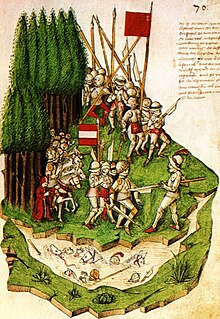The Battle of Morgarten occurred on 15 November 1315, when 1,500-strong force from the Swiss Confederacy ambushed a group of Austrian soldiers of the Holy Roman Empire on the shores of Lake Ägerisee near the Morgarten Pass in Switzerland. The Swiss, led by Werner Stauffacher, defeated the Austrians, who were under the command of Duke Leopold I.
Background[]
Toward the end of the 13th century, the House of Habsburg coveted the area around the Gotthard Pass as it offered the shortest passage to Italy. But the Confederates of Uri, Schwyz and Unterwalden, who had formalized the Swiss Confederacy in 1291, held imperial freedom letters from former Habsburg emperors granting them local autonomy within the empire.[1] In 1314 tensions between the Habsburgs and Confederates heightened when Duke Louis IV of Bavaria (who would become Louis IV, Holy Roman Emperor) and Frederick the Handsome, a Habsburg prince, each claimed the crown of the Holy Roman Emperor. The Confederates supported Louis IV because they feared the Habsburgs would annex their lands, which they had tried to do in the late 13th century. War eventually broke out after the Confederates of Schwyz raided the Habsburg-protected Einsiedeln Abbey, as a result of a dispute regarding access to pastures.[1]
Battle[]
Frederick's brother, Leopold of Austria, led a large army, including a small number of knights, to crush the rebellious Confederates. He planned a surprise attack from the south via Lake Ägerisee (also known as Lake Äegen or Lake Aegeri) and the Morgarten Pass, counting on complete victory. Johannes von Winterthur's chronicle of the battle puts the Austrian forces at 20,000, although that number is now believed to be inaccurate.[2] Another account, by Rudolf Hanhart, states that there were 9,000 men in the Austrian army,[3] while historian Hans Delbrück states that the Austrian army consisted of only 2,000 to 3,000 men, but that these were mainly well trained and equipped knights.[4]
The Confederates of Schwyz, supported by the Confederates of Uri, feared for their autonomy, but were not supported by the Confederates of Unterwalden who expected the army to approach from the west near the village of Arth, where they had erected fortifications. The size of the Confederate army is also disputed, with estimates ranging from 1,500 to around 3,000 or 4,000.[4] Nevertheless, regardless of their size, the Confederate militia lacked the training of the Habsburg knights, who were also better equipped. According to a legend recounted in Tait's Edinburgh Magazine in 1852, one Habsburg knight, Henry Huenenberg, recognising the superiority of his force and possibly concerned that victory over a "rabble" would be a disgrace, or in an act of chivalry, shot an arrow with a message attached into the Confederates' camp, telling them that the Austrians would advance through Morgarten on 15 November and that they should return to their homes.[5] In response, the Confederates prepared a road-block and an ambush at a point between Lake Ägerisee and Morgarten Pass, where a small path led between a steep slope and a swamp. When the Confederates attacked from above with rocks, logs and halberds, the Austrian knights had no room to defend themselves and suffered a crushing defeat, while the foot soldiers in the rear fled back to the city of Zug. About 1,500 Habsburg soldiers were killed in the attack.[6] According to Karl von Elgger, the Confederates, unfamiliar with the customs of battles between knights, brutally butchered retreating troops and everyone unable to flee. He records that some infantry preferred to drown themselves in the lake rather than face the brutality of the Swiss.[6] This established the Confederates' reputation as barbaric, yet fierce and respectable fighters.[citation needed]
Aftermath[]

Illustration from the Schweizer Chronik of Johannes Stumpf of 1547
Within a month of the battle, in December 1315, the Confederates renewed the oath of alliance made in 1291, initiating a period of growth within the Confederacy.[1] In March 1316, Emperor Louis IV confirmed the rights and privileges of the Forest Cantons. However, Leopold prepared another attack against the Confederacy. In response, Schwyz attacked some of the Habsburg lands and Unterwalden marched into the Bernese Oberland. Neither side was able to prevail against the other, and in 1318, the isolated Forest Cantons negotiated a ten-month truce with the Habsburgs which was extended several times. By 1323, the Forest Cantons had made alliances with Bern, and Schwyz signed an alliance with Glarus for protection from the Habsburgs.[1] Within forty years, cities including Lucerne, Zug and Zürich had also joined the Confederacy.[citation needed] The Confederate victory gave them virtual autonomy, and for a time, a peace with the Habsburgs that lasted until the Battle of Sempach in 1386.[citation needed]
See also[]
References[]
- ↑ 1.0 1.1 1.2 1.3 Battle of Morgarten in German, French and Italian in the online Historical Dictionary of Switzerland.
- ↑ Oechsli, Wilhelm (1891). Die Anfänge der Schweizerischen Eidgenossenschaft: zur sechsten Säkularfeirer des ersten ewigen Bundes vom 1. August 1291, verfasst im Auftrag des schweizerischen Bundesrates. pp. 348. http://books.google.com/books?pg=PA348&id=ajYwAAAAYAAJ#v=onepage&q&f=false.
- ↑ Hanhart, Rudolf (1829). Erzählungen aus der Schweizer-Geschichte nach den Chroniken, Volume 2. pp. 59. http://books.google.com/books?pg=PA58&id=DRxCAAAAcAAJ#v=onepage&q&f=false.
- ↑ 4.0 4.1 Delbrück, Hans. Geschichte der Kriegskunst im Rahmen der politischen Geschichte, Volume 3. pp. 572–3. http://www.zeno.org/Geschichte/M/Delbr%C3%BCck,+Hans/Geschichte+der+Kriegskunst/3.+Teil.+Das+Mittelalter/5.+Buch.+Die+Schweizer/2.+Kapitel.+Die+Schlacht+am+Morgarten.
- ↑ Tait, William; Christian Isobel Johnstone (1852). Tait's Edinburgh Magazine, Vol 19. pp. 244. http://books.google.com/books?pg=PA244&id=VT5NAAAAMAAJ#v=onepage&q&f=false.
- ↑ 6.0 6.1 Von Elgger, Karl (1868). Die Kämpfe am Morgarten in den Jahren 1315 und 1798: Festschrift für die Jahresversammlung der schweiz. Officiersgesellschaft in Zug im August 1868. pp. 10–11. http://books.google.com/books?pg=PA10&id=l7A9AAAAcAAJ#v=onepage&q&f=false.
| Wikimedia Commons has media related to Battle of Morgarten. |
The original article can be found at Battle of Morgarten and the edit history here.
